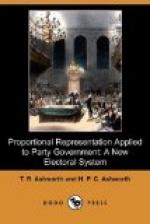In France, Belgium, Italy, and Germany an attempt has been made to check this evil by the double election. If at the first election no candidate secures an absolute majority of the votes, a second election is held, for which only the two candidates who head the poll at the first election are allowed to compete. One must then get an absolute majority. The double election has undoubtedly tended to prevent a further splitting up into groups, but the Continental countries offer such poor soil for the growth of party government that it has only restricted the contest to two factions in each electorate; and, of course, the dominant factions are not the same in the various electorates.
+The Advance Vote.+—In Australia the same evil has become increasingly evident, and it is now no uncommon thing for a candidate to be elected by less than one-third or one-quarter of the total votes. In Queensland a plan has been introduced to meet the evil, under the name of the Advance Vote, which is designed to secure the advantages of the French plan without the trouble and expense of a second election. The electors simply declare in advance at the first election how they would vote at the second election. All that is necessary is that they place the candidates in order of preference, 1, 2, 3, 4, &c. Then, instead of holding a second election between the two who have the greatest number of first preferences, it is merely necessary for the returning officer to consult each ballot paper and see which of these two candidates is higher in order of favour. Thus if one is marked 3 and the other 4, the vote is counted to the candidate marked 3. This device is assumed to give exactly the same result as the French plan, providing only that the same electors vote at both elections, and do not change their views between the two elections.




